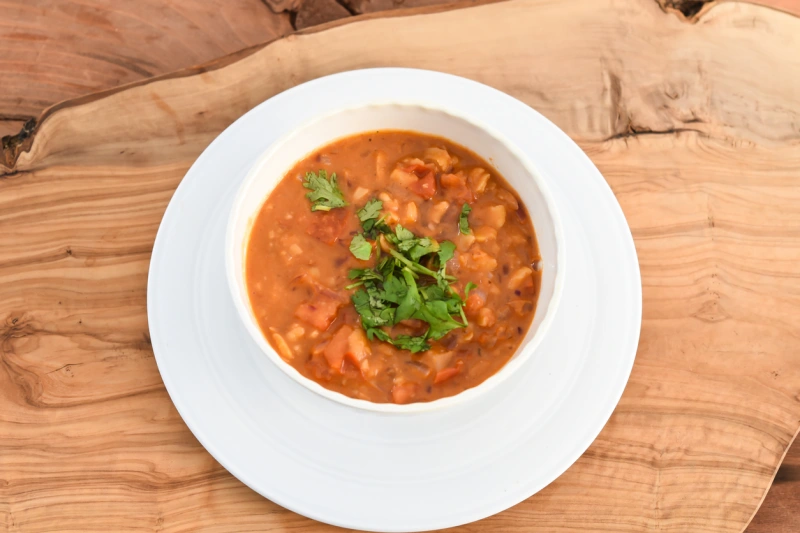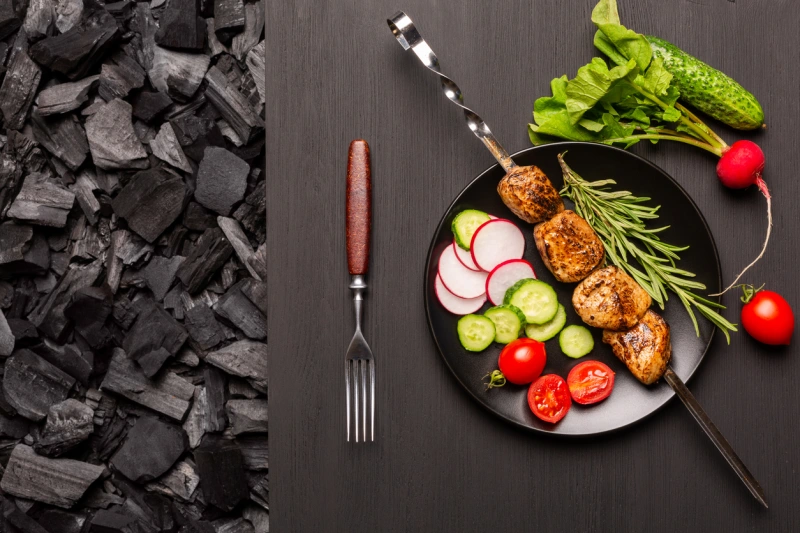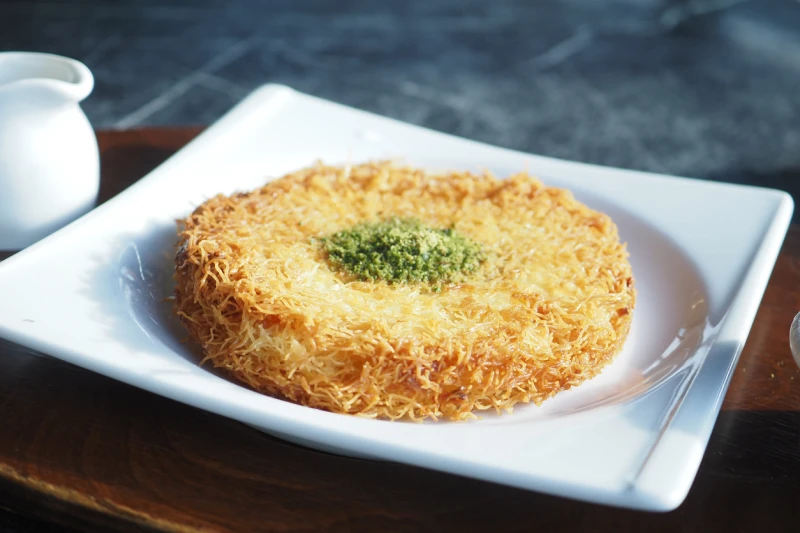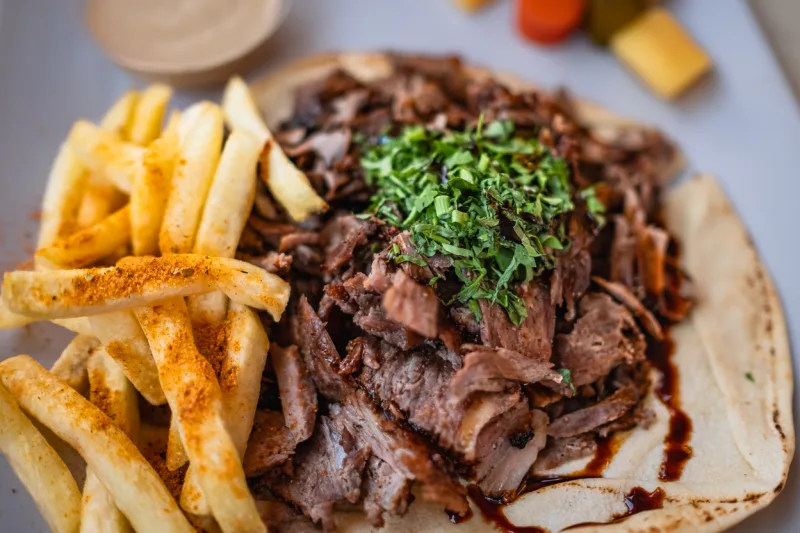Explore the top Egyptian dishes to try during your visit. From koshari and falafel to molokhia and stuffed pigeon, these traditional meals offer a rich taste of Egypt’s culinary heritage.
Ful Mudammas
Legend has it that this ancient Egyptian dish is as old as the Pharaohs. Ful Mudammas is a delicious breakfast dish and popular street food in Egypt that can be enjoyed at any time of day. It also starts with a fava bean base. Beans are soaked overnight, cooked, then served in a bowl and sprinkled with chopped parsley. Hard-boiled eggs are usually added (perfect for breakfast), and pita bread (again) is a necessary accompaniment. Dressing, consisting of olive oil, salt and pepper, pepper flakes, lemons, crushed garlic, and ground cumin, is drizzled on ful mudammas as desired.
Fish Sayadiya
Seafood fans won’t want to miss the chance to eat one of Egypt’s prized fish dishes. Chefs clean a whole white fish, season it with salt, pepper, and spices, then pan-fry before finishing the fish in the oven with a sauce created from onion, bell pepper, and tomato. Being served with rice, fish sayadiya can be garnished with toasted almonds, which adds a nice crunch to this oh-so flavorful dish.

Kabab wa kofta
No Egyptian food list can be completed without Kofta! This meat-based dish is also called the meatloaf of Egypt. It mainly consists of lamb, beef, onion, garlic, and spices (kaba wa kofta can be on the spicy side) and fresh mint. It’s actually ground meat that is formed into balls or chunky oblong shapes and can be cooked on skewers. This kofta can also be cooked directly on the grill sans skewers. It usually pairs up well with salad and Egyptian bread.
Om Ali
This traditional and decadent bread pudding originated in Egypt but is a ubiquitous dessert in other regions of the Middle East. Folklore claims that this dish dates back to the 13th century and is named after Sultan Ezz Din Aybak’s wife. There are several tales as to why the dessert took her name, some of which are dark and distressing, so we’ll skip that (we don’t want to take anything away from this fabulous dessert!). Om Ali – also Omali, Umm Ali, and Oumm Ali – translates to “Ali’s mother.”

Fattah
Fattah is a quite popular dish throughout the Middle East, but each country makes it a little bit differently. In the Levant, it’s made with yogurt and garbanzo beans, but in Egypt, fattah has neither of these ingredients. Fattah is a rice dish made with fried pieces of bread, garlic and tomato sauce, and lamb or beef. Newer, trendier restaurants get a little fancy and make fusion options such as chicken shawerma fattah, but for the good old traditional version, head to Abou el Sid. The dish sounds a bit strange, but it tastes amazing!
Fiteer Baladi
Also known as Egyptian pizza, Fiteer Baladi is quite buttery and full of artery-clogging goodness. Egypt is famous for heavy food, in case you haven’t realized. Fiteer is made of layers upon layers of filo dough and cooked in a giant brick oven. The original is served plain, but it can also be ordered sweet (with honey, syrup, and/or powdered sugar) or savory (with meat, vegetables, and/or cheese). Fatatri El Hussein (aka Egyptian Pancake House) is the pick of choice here. Be warned: this is a hole in the wall place with a small seating area, so don’t expect anything fancy. Despite the casual ambiance, the food here is some of the best I’ve ever had!

Kunafa
You just can’t deny the fact that no list of must-try dishes can be complete without dessert. Kunafa is one of Egypt’s most popular and delicious desserts. Traditionally served during Ramadan to keep people full during fasting hours, the original version comprises two layers of extra-thin semolina flour noodles. These are baked until they turn crunchy and are arranged around a central filling of soft cheese (usually ricotta) and soaked in syrup. Alternatively, the noodles can even be replaced with thin strips of filo pastry or spun shredded wheat, while fillings vary from mixed nuts to custard. There are still some Egyptian bakeries that have become increasingly adventurous with their Kunafa fillings, and that too with modern interpretations using mango, chocolate, and even avocado.
Molokhia
This is another vegan meal that is named after the plant used to make it. It is prepared using molokhia plant leaves, which are cooked with lemon juice, garlic, and coriander to make a thick, dark green soup.
When served, molokhia may not look appetizing because it has a slimy, mucus-like appearance. But I guarantee you it tastes better than it looks, and it has many health benefits. You can have molokhia with bread, rice, or chunks of beef, chicken, or rabbit meat. It’s an absolute must when it comes to Egyptian cuisine.

Egyptian Shawarma
Shawarma is now a popular street food in many cities across the world. In the streets of Cairo, the capital city of Egypt, shawarma joints with mouth-watering beef or chicken rotating on a grill are common. As you tour the city you can stop at one of these places and grab a shawarma.
To make the Egyptian shawarma slices of marinated meat carved from a slowly revolving skewer are wrapped in a bun together will tomatoes, onions, spices, and fatty sauces. When you take the first bite of the shawarma your taste buds will be blown away. I wouldn’t be surprised if you order 3 or 4 of this because they are so tasty.
Well, the bottom line is that you should definitely try all these delicious Egyptian dishes at least once in your life. Book now with Nile Cruse Vacation and try all the traditional Dishes1
